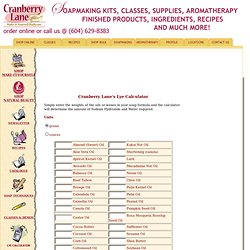

MMS - Home Page. Basic Soap Making Recipes - Make Natural Homemade Soap. 71 Of The World's Best Homemade Soap Recipes. Soap Making Tips & Tricks. The following are several Tips & Tricks submitted by Oregon Trail Customers (and a few by me!).

We would love to hear your own personal Tips & Tricks and even add them to our resource list. If you have a great tip or trick to submit, please click on the "Submit Tip" button on this page or send us an email through our "Contact Us" page. Tips from Suz Q: How much flavor should I use when making Lip Products? A: Lip flavors are like anything else, some are stronger than otherrs, but... Q: Are these flavors sweetened? Tips for Using Beeswax:Dedicate separate utensils for working with beeswax. Suz Equipment Care To keep your scale nice, slip it into a lightweight inexpensive plastic bag.
Suz K. The best way I have found to clean containers with melted wax is to put it in the microwave for a few seconds to re-melt any wax, then wipe it out with paper towels. Happy Soaping, Kathy, Ozark County Arts & Crafts Cold Process Soap Making While the lye is cooling, I start weighing the oils. Juan P. Jen Holly O. Cranberry Lane Make-it-Yourself Bodycare, Soap and Soapmaking Supplies, Soapmaking Kits, Essential Oils, Herbs, Waxes, Molds, Lye Calculator, and Kits. Cranberry Lane's Lye Calculator Simply enter the weights of the oils or waxes in your soap formula and the calculator will determine the amount of Sodium Hydroxide and Water required.

Units Neither the author nor the company can be held responsible for damage, injury or otherwise resulting from the use of the lye calculator, formulas, information or materials listed. | Home | Company Profile | On-Line Store | Newsletters | | Store Hours & Locations | Lye Calculator | Catalogue Request | | Soapmaking Instructions | contact us ©2011 Cranberry Lane Natural Beauty Products. Soap Making: Learn how to make soap. Saponification-The process of Making Soap (Theory) : Class 10 : Chemistry : Amrita Online Lab. To study the saponification reaction for preparation of soap.

Soaps and detergents are essential to personal and public health. They safely remove germs, soils and other contaminants and help us to stay healthy and make our surroundings more pleasant. Soaps are made from fats and oils or their fatty acids. What are fatty acids? Fatty acids are merely carboxylic acids consisting of a long hydrocarbon chain at one end and a carboxyl group (-COOH) at the other end. Saturated fatty acids:Fatty acids contain carbon-carbon single bonds called saturated fatty acids. Unsaturated fatty acids:Unsaturated fatty acids contain one or more double bonds between carbon atoms. If the fatty acid has a single carbon-carbon double bond in the molecule, it is known as a mono-unsaturated fatty acid.
If a fatty acid has two or more carbon-carbon double bonds in the molecule, it is known as poly-unsaturated fatty acid. Linoleic acid { CH3(CH2)4CH=CHCH2CH=CH(CH2)7COOH } is a poly-unsaturated fatty acid. Soap and Saponification - Chemistry. Preparation & Chemical Structure One of the organic chemical reactions known to ancient man was the preparation of soaps through a reaction called saponification. Natural soaps are sodium or potassium salts of fatty acids, originally made by boiling lard or other animal fat together with lye or potash (potassium hydroxide). Hydrolysis of the fats and oils occurs, yielding glycerol and crude soap. In the industrial manufacture of soap, tallow (fat from animals such as cattle and sheep) or vegetable fat is heated with sodium hydroxide. Once the saponification reaction is complete, sodium chloride is added to precipitate the soap. The crude soap obtained from the saponification reaction contains sodium chloride, sodium hydroxide, and glycerol.